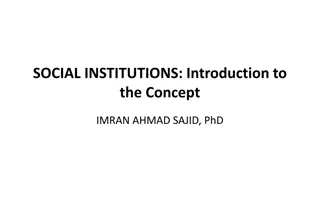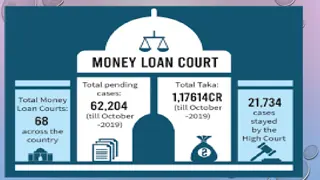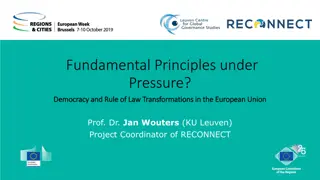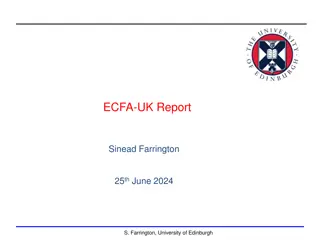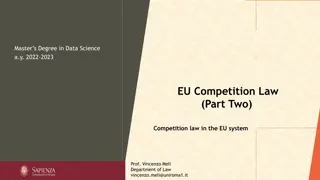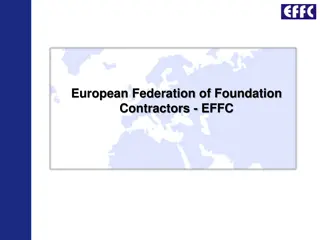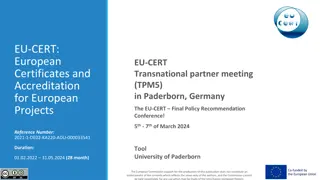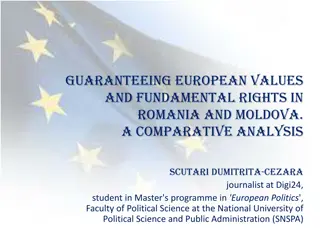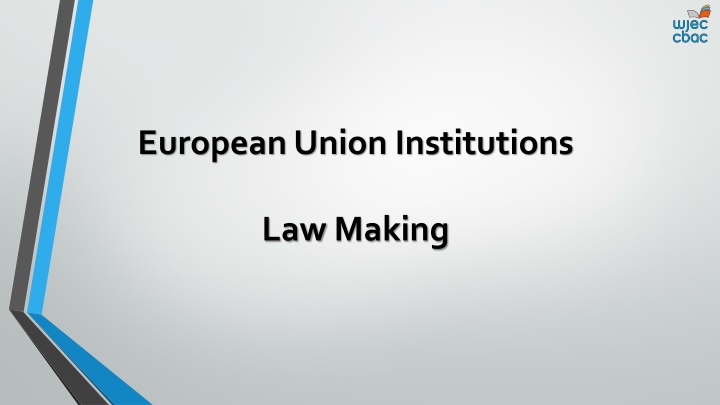
European Union Institutions and Legal Framework
Explore the role and evolution of key European Union institutions such as the Commission, Council, Parliament, and Court of Justice. Learn about the establishment of the EU legal order post-WW2 and its growth from the Coal and Steel Community. Discover the functions of the Commission in proposing legislation and monitoring EU law, along with the decision-making prowess of the Council in adopting Union legislation.
Download Presentation

Please find below an Image/Link to download the presentation.
The content on the website is provided AS IS for your information and personal use only. It may not be sold, licensed, or shared on other websites without obtaining consent from the author. If you encounter any issues during the download, it is possible that the publisher has removed the file from their server.
You are allowed to download the files provided on this website for personal or commercial use, subject to the condition that they are used lawfully. All files are the property of their respective owners.
The content on the website is provided AS IS for your information and personal use only. It may not be sold, licensed, or shared on other websites without obtaining consent from the author.
E N D
Presentation Transcript
European Union Institutions Law Making
Objectives Explain the role of the four main European institutions i.e. the Commission, the Council, the European Parliament and the Court of Justice of the European Union Explain the judicial and supervisory role of the Court of Justice of the European Union Explain the role of the European Court of First Instance
The European Legal Order EU established after WW2 to assist in physical and economic reconstruction. Main aims to promote economic development of member states and improve living standards of Union citizens. Since expanded to include social and environmental policy, monetary and political union. To achieve aims, EU has established its own legal institutions and laws.
European Union Institutions The European Union grew out of the European Coal and Steel Community, founded in 1951 with 6 members: Belgium, the Netherlands, Luxembourg, West Germany, France and Italy Its purpose was to pool the countries coal and steel resources.
European Union Institutions The Coal and Steel Community was later joined by the European Economic Community and the European Atomic Energy Community . The European Union was formed in 1993, combining the three Communities with a common foreign policy and co-operation in criminal matters. UK joined in 1973. Now 28 members though the UK may leave (Brexit)
European Union Institutions The Commission -main executive body headed by Commissioners (28 of them) who are appointed by the member states subject to approval by the Parliament, for 5 years. Commissioners are independent role is to represent the interests of the EU. Commission - Proposes and drafts EU legislation, negotiates trade agreements and draws up annual budget. Ensures that member states uphold EU law. Re Tachographs: EC Commission v UK (1979)
European Union Institutions The Council-main decision-making and legislative body Represents the interests of individual member states Most powerful of the institutions No permanent membership Adopts Union legislation based on proposals from the Commission and after consulting the Parliament European Council- related institution -major policy making body -meets at Euro-Summits ( Art. 2 of the Single European Act 1986).
European Union Institutions European Parliament- has mainly consultative and advisory role Members elected in their own countries (MEPs) every 5 years Parliament exercises a supervisory role over the Commission Can veto the appointment of the Commission and dismiss the whole Commission Reports on the Council 3 times a year Can bring actions against other EU institutions Role of the Parliamentary Ombudsman.
European Union Institutions The Court of Justice of the European Union supervises the application of EU Law Sits in Luxembourg 28 judges appointed for a period of 6 years Judges assisted by 8 Advocates General Since 1989 ECJ assisted by European Court of First Instance Constitutional court, provides definitive interpretations of EU law.
European Union Institutions The European Court of Justice 2 functions: judicial role and a supervisory role. Judicial Role: Hears disputes against member states and cases against European institutions e.g. Re Tachographs: EC Commission v UK (1979) United Kingdom v Council of the European Union (1996)
European Union Institutions The European Court of Justice - Supervisory Role Article 267 Treaty on the Functioning of the European Union any court can refer a question on EU law to the ECJ The referral system ensures that the law is interpreted the same throughout the EU Reference MUST be made if the national court is the final appeal court Bulmer v Bollinger guidelines on when a court in a Member State should refer.
European Union Institutions In deciding whether a ruling is necessary, English courts use the Bulmer v Bollinger (1974) guidelines - e.g. not necessary where: ECJ has previously ruled on the same point. Point is reasonably clear and free from doubt (the acte clair doctrine). The facts of the case had not yet been decided. It would not be conclusive of the case.
European Union Institutions Supervisory Role - Art.267 TFEU: Customs and Excise Commissioners v APS Samex (1983) R v International Stock Exchange, ex parte Else (1993) Marshall v Southampton and South West Hampshire Area Health Authority (1986) ECJ is not an appeal court it assists national courts, the actual decision remains the task of the national court. ECJ IS not to be confused with the European Court of Human Rights, this court is NOT an institution of the EU. Mandatory and discretionary referrals.
European Union Institutions The European Court of First Instance: Established in 1988 Single European Act Art.225 Aim to reduce the workload of the ECJ Limited jurisdiction Deals with mainly internal litigation.
Making European Legislation Council, Commission and Parliament all have a role in making EU law All legislation starts with proposal from the Commission Parliament has an increased role but still limited Increasingly, the passing of EU legislation requires the approval of the European Parliament as well as the Council, through the ordinary legislative procedure (previously known as the co-decision process) Ordinary legislative procedure gives the same weight to the European Parliament and the Council of the European Union on a wide range of areas (for example, economic governance, immigration, energy, transport, the environment and consumer protection). The vast majority of European laws are adopted jointly by the European Parliament and the Council.
Conclusion UK membership of EU has had wide-ranging effects particularly regarding sovereignty, while this could in theory be reversed, this is unlikely to occur in practice. Therefore, Assuming continued UK membership, EU law will play an increasingly significant role within the English Legal System. However, what will happen post-Brexit? Research the current position.





